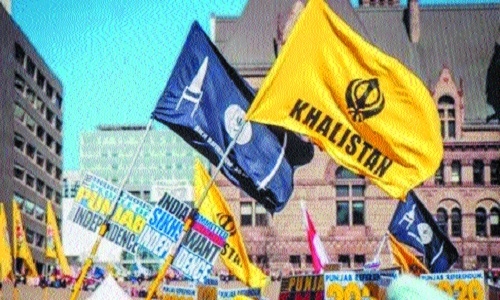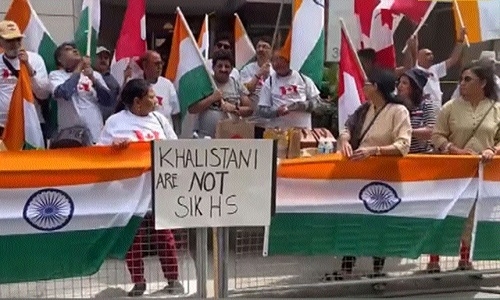Khalistan: Separatist clot in pure blood of Indian Punjab
| Date :28-Jul-2023 |

By Kartik Lokhande
There is no other ‘ism’ more dangerous than ‘terrorism’. For, those professing this ‘ism’ do not realise that there is ‘error’ in the word ‘terror’. In case of India, which has been fighting various insurgencies and terrorist acts since independence, if there is one chapter that entwines several complex issues, then it is of Khalistan extremism. Not only has it left a permanent scar on the country’s history but also has continued to destroy the economic, social, and political fabric of India’s integral part -- Punjab -- though the extremists now operate from foreign soil. Though an overwhelming majority of Sikhs does not support Khalistani separatists, International forces have been misusing these separatists to serve their covert anti-India agenda. In the recent times, Khalistani extremists operating out of especially Canada, the US, and the UK have been in the news for reviving the ghost of the Khalistani separatism. Though the social media-fed younger generation carries a perception that the separatism is only some 40-odd years old, there is a longer history. The pro-Khalistan lobby projects that the problem dates back to the British Raj, but conveniently uses the UK to find shelter there. To understand the history, one has to go back to the era when India won her independence from the British rulers.
According to some authentic accounts, Sikh migrants from Punjab constituted the single largest group of Indian origin in the Indian diaspora in the UK, the US, and Canada in the first few years after India won her independence
from the British. Some had migrated to Canada to work in saw mills, factories and public transportation systems. Most of these migrants earned their living by working as drivers and conductors in municipal public transportation systems in the UK. Some of the farmers migrated to California in the US, where they did extremely well in citrus farming. Everything was working well for them until in the late 1950s and early 1960 when their employers particularly in the public transport companies in the UK asked them to shave of their beard and stop wearing turbans. In other countries, local municipal authorities created hurdles for them in getting permissions for acquiring land for constructing Gurudwaras (places of worship). The problem escalated when the affected Sikhs raised the matter with the Indian High Commission in London and it declined to intervene.

In his extraordinary book ‘The Kaoboys of R&AW: Down Memory Lane’ (the term ‘Kaoboys’ used in honour of the R&AW’s founding father R N Kao), B Raman has mentioned, “Jawaharlal Nehru, who was India’s Prime Minister at that time, followed a hands-off policy with regard to the migrants of Indian origin living abroad. He was against the Government of India intervening on their behalf with the host governments... Dissatisfaction over the reluctance of the Government of India to vigrously take up such issues with other Governments gave rise to a feeling among some of the Sikh residents of the UK, the US, and Canada that only by creating an independent State for the Sikhs would they be able to have their religious rights protected. A group of Sikh bus drivers and conductors in the UK formed an organisation called the Sikh Home Rule Movement under the leadership of one Charan Singh Panchi. Some well-to-do Sikh farmers in the US floated an organisaton called the United Sikh Appeal, modelled after the United Jewish Appeal...” However, a majority of Sikh communities in the West did not support the idea of an independent Sikh State.
This is said to have marked the beginning of Khalistani separatism. However, those falling for such separatist appeals mainly were swayed by situations they faced in foreign countries and their bond with their Indian roots had probably been weakened by immediate interests. Meanwhile, in India, a ‘Sikh Question’ was in making. Durga Das, legendary journalist was Convenor of Punjab Reconstruction Committee of which Bakshi Tek Chand, former Chief Justice of Lahore High Court, was Chairman. On September 20, 1947, a delegation of the committee met Pt Jawaharlal Nehru, the first Prime Minister of India. As per the extract from the minutes of the meeting that Durga Das has recorded in his seminal book ‘India from Curzon to Nehru and After’, the committee pressed for resettlement of refugees in East Punjab and sought land for resettlement near Delhi. A section of the Sikhs that time was so agitated that they wanted separate homeland for them. Some associate this thinking of ‘separate homeland’ to be the genesis of the demand for ‘Khalistan’.
As Durga Das has mentioned in his book about the said meeting, “Pandit Nehru, replying, said that Master Tara Singh (highly respected Sikh leader of the time) had met him the previous day and that he had asked the Sikh leader whether his community wanted Khalistan (a Sikh State). Pandit Nehru said he had never seen Master Tara Singh so crestfallen as on that day. The Sikh leader vehemently protested against any idea of Khalistan and said that the Sikhs, being a very small section of the people of India, live with the Hindus as brothers.” Within years, the Sikh extremism abroad grew bigger. Over the years, the political landscape in India changed. India had fought wars with Pakistan to protect own integrity. Getting bloody nose several times, and especially in Bangladesh Liberation War in 1971, which dismembered East Pakistan from the West Pakistan, the fundamentalist Pakistani establishment wanted to destabilise India. From hereon, Pakistan and International forces that were not happy with Indira Gandhi emerging as a global leader started using the Sikh separatist movement particularly in the UK to suit their agenda.